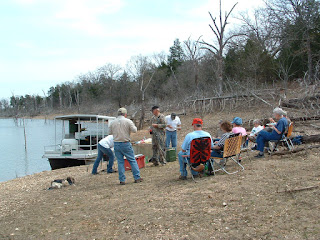As
much as I love to hunt and fish, I was born a naturalist first and foremost,
and I have made much of my living actually working as a paid naturalist for two
state park systems, for the National Park Service and for a natural heritage
commission. I continue that even
now.
Several times a year I take
groups of 10 to 15 people to that secret place that is quiet and serene, and
wild and beautiful. There are no roads into it; I get there via boat. In fact I
am going there this week. I will head up into familiar hills, which make up the
watershed of Truman Lake, about 120 thousand acres of undeveloped public land.
In
the woodlands, where giant oaks and hickories are as big as any I have ever
seen anywhere, there are still rubs made by buck deer not long ago. I found
some big shed antlers there last year, a twelve-point headdress for a buck that
survived the deer season. Not far away are the remains of a rock foundation
only about 10 by 15 feet, where an old cabin once stood, built more than 120
years ago. There is the remains of
an iron bedstead there, nearly rusted away, and nothing more. Folks lived here
for many years. I found a 1922 license plate there once.
But
a huge cedar growing out of the middle of it has to be 80 years old, so the
cabin has been gone at least that long.
I wonder what the people were like who lived there a hundred years ago
and much farther back. Wouldn’t it be something to go back in time and meet
them? I imagine the six piles of rock on a small flat area above the creek are
graves of some of them.
Last
year I sat down against a big chinquapin oak and marveled at the frenetic
chatter of more than a thousand robins in an acre or so of woods along the
creek. In sitting, I noticed that woodrats had an advanced nest around a nearby
tree with a root system favoring a tunnel beneath it. It is quite an arrangement of sticks. These woods are filled with dens of one
type or another, beneath rocks and crevices, under the roots of huge fallen
giants, in the boles of standing, but rugged, den trees. There is such a
variety of wild creatures here it is amazing. The tracks along the creek tell me that. A couple of years ago I photographed
the tracks of a wandering mountain lion not far from the place where start.

This is my secret place, this
large acreage of land set aside on Truman Lake. For once they made a lake right, preserving so much. Never ever, anywhere else have I seen individual
species of white and chinquapin oak, cedar, Osage orange, hickory, black cherry
and other species anywhere as large as I have found here. It is typical of the northern Ozarks,
with a winding small creek, stretches of cedar glade and open, mature forest. There,
I can lose myself, and wonder if God isn’t behind me somewhere, smiling because
I have returned to marvel in the greatness of His unspoiled creation. There is
no greater place to talk to God.
In
the lateness of the day last year, as small flakes of snow began to fall and
robins flew up in great flocks, I gained my feet and continued on, slowly,
watching for whatever I may not have seen on other trips to this forest. I
found a huge cedar with the hole beneath it, making it appear to be a miniature
version of those California redwoods where roads pass through and beneath
them. Not much farther along the
game trail I follow, there was an oak tree with a huge hardened mushroom
growing up along its base nearly three feet off the ground. It looked a great deal like some
bird-bath which nature had fashioned. In all my life I have never seen any of
those shelf-mushrooms that large.
My secret place will be blooming again
soon with scattered wild plum and redbuds, and the skies will be bright
blue. New life is only a few weeks
away. Baby squirrels are being
born right now in the many den trees. Red-tailed hawks and great horned owls
are mating. It is the beginning of mating season for many furbearers too, and
it is hard to realize that, in the bleakness of February. But no matter when I come I have a
feeling of peace I find nowhere else.
It is easy to forget that there is a conflict or problem of any kind
anywhere on earth.
You
can go with me sometime this if you would like. In March, I will take ten to fifteen people at a time into
this secret place of mine on a big pontoon boat, and we will make a day of it,
hiking woodland which has no beaten path.
At noon we have a fish fry for lunch, fresh fish I have caught only days
before with beans and potato salad, coffee and brownies. After dinner and a
rest, we take another short hike along a creek then head in at sunset. If you want to go along, contact me and
I will send you the details. Then
in April, I will take another group to my secret places via boat and teach them
to find mushrooms and shed deer antlers.
In October I will take groups to see a different world that fall colors
create.











